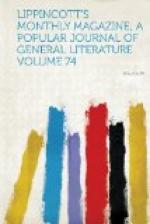“Leslie’s burner is a form of the argand. The gas, instead of issuing from holes pierced in a solid ring, is conducted to the flame in separate small tubes upward of an inch long. Twenty-eight of these tubes are inserted in a ring two inches in diameter, and converge to one inch at the ends, where the gas escapes. These tubes become hot very quickly when the gas is lighted, and it issues at a high temperature. Here is the result of a test made by Mr. Clegg, and given on page 344 of his valuable work on coal gas:
COMMON
ARGAND, FIFTEEN HOLES.
Consumption per hour in cubic feet:
6
feet, light = 17.4 standard candles.
5
feet, light = 13.64 standard candles
LESLIE’S BURNER, TWENTY-EIGHT HOLES.
6
feet, light = 14.73 standard candles.
5
feet, light = 11.28 standard candles.
“In experimenting with common burners, argand and others, it is found that, if the aperture in the tip is too small for the orifice in the body of the burner, the escaping gas is too highly heated and is consumed too quickly. So with Leslie’s burner in an increased degree. Theories brought to the test of experiment are often disappointing.”
The chemist now proceeded to illustrate his harangue with the argand upon the table, which he lighted and turned on full, without replacing the chimney. The dull-red flame streamed up to a height of eight inches or more, waving and smoking slightly. He now turned down the gas and replaced the chimney, then set the tap at the same angle as before. “Here,” said he, “we have a flame barely four inches high—of brilliant white—which gives more light than the taller flame did. The cause of the shortening of the flame is the more rapid combustion of the gas, owing to the increased draught or air-supply in the chimney. From the greater intensity of this flame a much larger quantity of light is produced than by the longer flame. If too tall a chimney is used, the flame is shortened still more and its brilliancy increased, but not to a degree sufficient to compensate for the diminished surface. The light, you are doubtless aware, comes from the incandescence of the carbon, heated by the union of the hydrogen of the gas with a portion of the oxygen of the air.”
The chemist now read from his manuscript again: “Carburetted hydrogen of a passably good quality requires two volumes of pure oxygen for its complete combustion and conversion into carbonic acid and water. Atmospheric air contains, in its pure state, about twenty per cent. of oxygen; therefore, one cubic foot of gas requires for its perfect combustion ten cubic feet of air. If less be admitted to the flame, a quantity of free carbon will escape, and be deposited in the form of black smoke. If an excess of air be admitted, we shall find that the quantity of nitrogen accompanying this excess has a tendency to extinguish the flame, while it takes no part in the elective affinity constantly going on between the other elements—namely, hydrogen, oxygen and the vapor of carbon.




